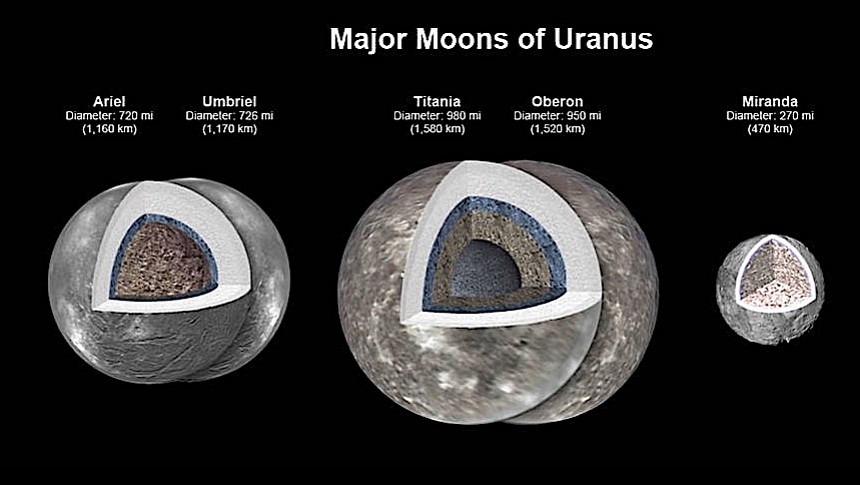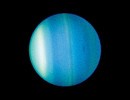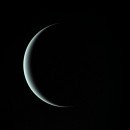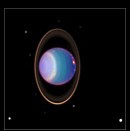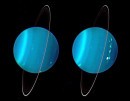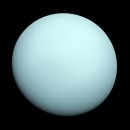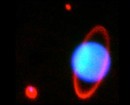It's been a long time since we became aware of water being abundant in our solar system (and beyond it, for that matter). As a key ingredient for the existence of life as we know it, but also as an important resource for our future space exploration efforts, water still is a key focus of science teams across our planet.
Despite our civilization focusing for now on the exploration of the Moon and Mars, future missions will go deeper into our immediate neighborhood, trying to shed some light on fascinating places far away. And one potential target for future missions is Uranus.
An ice giant by trade (one of two we know of, together with Neptune), Uranus has the honor of being the first planet to have been spotted by means of a human telescope. It happened all the way back in 1781, and was initially mistaken for a comet or just another star by the one who found it, British astronomer William Herschel.
Since that time we've learned quite a lot about the place which was eventually named after the Greek god of the sky. Now that we know how and where all other planets are, we classified this one as the seventh planet from the Sun, and the third one by size in our little corner of the Universe.
A fascinating fact about it is that it is surrounded, just like Saturn, by rings. There are 13 that we know of, and almost all of them were beautifully snapped on camera by the James Webb space telescope back in February 2023. Accompanying the rings in orbit around the planet are 27 known moons of different sizes. It is generally believed all of the inner ones are half rock and half water ice, while the ones further out just asteroids trapped by the giant's gravitational force.
Despite the many pieces of hardware we've sent into space these past few decades, only one spacecraft went past Uranus, and that's only because the planet happened to be on the way: Voyager 2. The flyby happened in 1986, and saw the spacecraft coming within 50,600 miles (81,500) of the planet's upper atmosphere.
The second spaceship to be in the vicinity of the planet, New Horizons, did cross the planet's orbit in 2011, but at the time it arrived there Uranus together with its rings and its moons were all in another location on their orbit around the Sun.
Voyager still is to this day one of the most important sources of knowledge about Uranus and its surroundings. It discovered ten of the 27 Moons, but also two of its rings. And it also gathered data that are still being studied today.
One of the teams doing that is from NASA's Jet Propulsion Laboratory and is led by Julie Castillo-Rogez. This crew published in December last year a study in the Journal of Geophysical Research, hinting more or less of Uranus' most important moons being made not only of rocks and ice, but also of vast oceans of liquid water.
The findings are based on data gathered by Voyager, and cross-referenced with info from other spacecraft that have been studying ocean worlds elsewhere (Galileo, Cassini, Dawn, and New Horizons). They point to at least four of the largest Uranus Moons, namely Ariel, Umbriel, Titania, and Oberon, hiding vast oceans under their icy crusts. How vast? Well, some could be as deep as dozens of miles.
Uranus' moons do not have a heat source nearby to keep them warm and allow for the presence of liquid water, so scientists believe heat comes through radioactive decay or some other means from the moons themselves. They seem to be "insulated enough to retain the internal heat" and, on top of that, the presence of ammonia and salts that can act as anti-freeze could also explain the presence of liquid water.
And there also might be other internal heat sources inside the moons, which release hot liquid, helping an ocean maintain a warm environment. This is most likely to happen on Titania and Oberon, two places with a high chance of being home to some sort of life forms in this ocean environment.
Despite the findings of the study tough, the team behind it warns that there’s still a lot of work to be done before we can say we have a clear image of those distant places. "We need to develop new models for different assumptions on the origin of the moons in order to guide planning for future observations," said Castillo-Rogez in a statement NASA released this week.
The team's findings could still be crucial in the planning of a future mission to Uranus, which will most likely prioritize these moons for observation. Sadly, in the immediate future, with the exception of a Chinese mission, not much is planned.
An ice giant by trade (one of two we know of, together with Neptune), Uranus has the honor of being the first planet to have been spotted by means of a human telescope. It happened all the way back in 1781, and was initially mistaken for a comet or just another star by the one who found it, British astronomer William Herschel.
Since that time we've learned quite a lot about the place which was eventually named after the Greek god of the sky. Now that we know how and where all other planets are, we classified this one as the seventh planet from the Sun, and the third one by size in our little corner of the Universe.
A fascinating fact about it is that it is surrounded, just like Saturn, by rings. There are 13 that we know of, and almost all of them were beautifully snapped on camera by the James Webb space telescope back in February 2023. Accompanying the rings in orbit around the planet are 27 known moons of different sizes. It is generally believed all of the inner ones are half rock and half water ice, while the ones further out just asteroids trapped by the giant's gravitational force.
Despite the many pieces of hardware we've sent into space these past few decades, only one spacecraft went past Uranus, and that's only because the planet happened to be on the way: Voyager 2. The flyby happened in 1986, and saw the spacecraft coming within 50,600 miles (81,500) of the planet's upper atmosphere.
Voyager still is to this day one of the most important sources of knowledge about Uranus and its surroundings. It discovered ten of the 27 Moons, but also two of its rings. And it also gathered data that are still being studied today.
One of the teams doing that is from NASA's Jet Propulsion Laboratory and is led by Julie Castillo-Rogez. This crew published in December last year a study in the Journal of Geophysical Research, hinting more or less of Uranus' most important moons being made not only of rocks and ice, but also of vast oceans of liquid water.
The findings are based on data gathered by Voyager, and cross-referenced with info from other spacecraft that have been studying ocean worlds elsewhere (Galileo, Cassini, Dawn, and New Horizons). They point to at least four of the largest Uranus Moons, namely Ariel, Umbriel, Titania, and Oberon, hiding vast oceans under their icy crusts. How vast? Well, some could be as deep as dozens of miles.
Uranus' moons do not have a heat source nearby to keep them warm and allow for the presence of liquid water, so scientists believe heat comes through radioactive decay or some other means from the moons themselves. They seem to be "insulated enough to retain the internal heat" and, on top of that, the presence of ammonia and salts that can act as anti-freeze could also explain the presence of liquid water.
Despite the findings of the study tough, the team behind it warns that there’s still a lot of work to be done before we can say we have a clear image of those distant places. "We need to develop new models for different assumptions on the origin of the moons in order to guide planning for future observations," said Castillo-Rogez in a statement NASA released this week.
The team's findings could still be crucial in the planning of a future mission to Uranus, which will most likely prioritize these moons for observation. Sadly, in the immediate future, with the exception of a Chinese mission, not much is planned.
